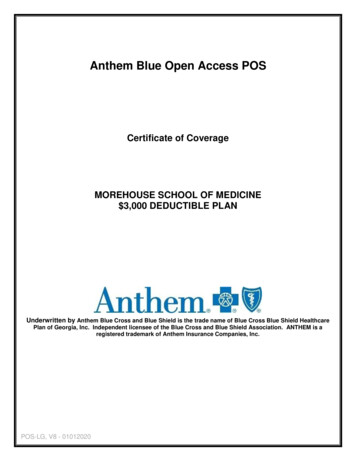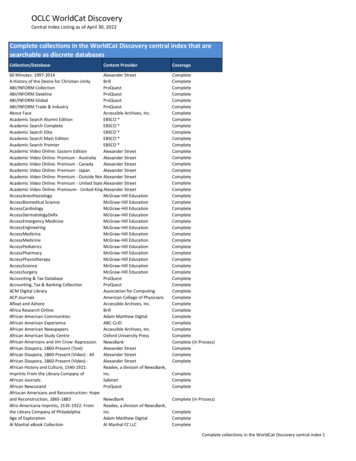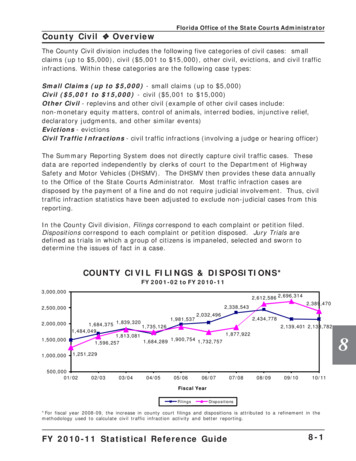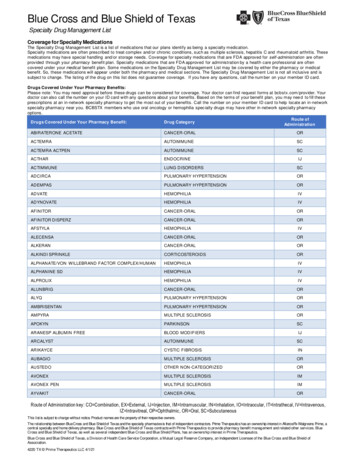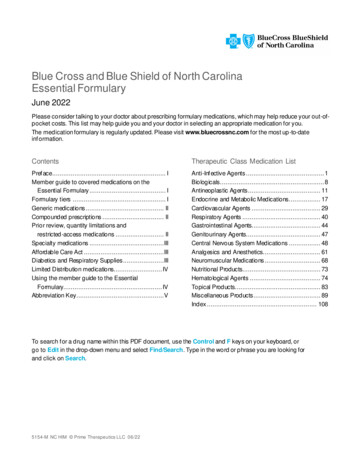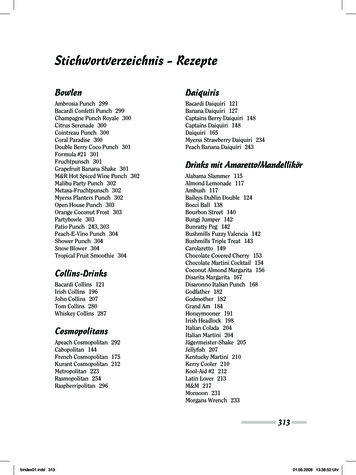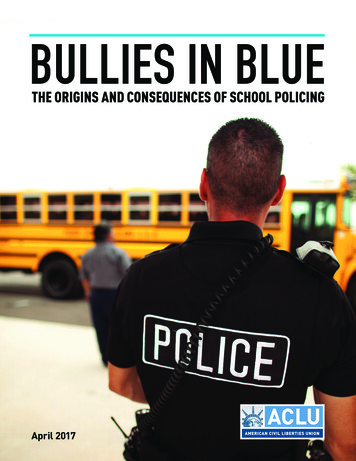
Transcription
BULLIES IN BLUETHE ORIGINS AND CONSEQUENCES OF SCHOOL POLICINGApril 2017
BULLIES IN BLUEThe Origins and Consequences Of School PolicingAmerican Civil Liberties Union125 Broad Street,New York, NY 10004 2017 ACLU FoundationAcknowledgementsThe principal authors of this report are Megan French-Marcelin, ACLS/Mellon Public Fellow and PolicyResearch Manager,and Sarah Hinger, ACLU Racial Justice Program staff attorney. Kali Cohn, of the ACLU of Texas, partnered in investigatingand analyzing school district police department policies in Texas. Johanna Miller, of the New York Civil Liberties Union,provided thorough review and feedback. Vanessa Hernandez, of the ACLU of Washington, partnered in investigating andreporting incidents in Washington state. Center for Justice and Equality Director Jeff Robinson, Racial Justice ProgramDirector Dennis Parker, Susan Mizner and Claudia Center of the Disability Rights Project, Nicole Kief and Crystal Kayiza,advocacy and policy associates, Harold Jordan, of the ACLU of Pennsylvania, Victor Leung of the ACLU of SouthernCalifornia, Linnea Nelson of the ACLU of Northern California, Matthew Simpson, of the ACLU of Texas, and KimHumphrey, of the ACLU Maryland, provided invaluable feedback and editorial input. Racial Justice Program paralegalNina Papachristou and assistants Daniel Marks and Gisselle Perez-Leon made substantial contributions to the researchand data analysis for this report. This report would not exist without the research support of Racial Justice Programinterns. Adina Ellis, Stacy Sullivan, Michelle Michalos, Elizabeth Beresford, Molly Kaplan, Robin Schulman, AlexandraRinge, and Raymond Gilliar provided communications, graphics, production, and additional support in the productionof this report.Cover Photo: Bob Daemmrich/Alamy Stock PhotoImage used for illustration purposes only. Any persons featured bear no association to events described herein.
BULLIES IN BLUE: THE ORIGINS ANDCONSEQUENCES OF SCHOOL POLICINGIntroduction . 2The Origins of School Policing . 3Demands for Equality Met With Calls for Law and Order . 3Making Delinquency . 4Creating Moral Panic . 6Broken Windows Discipline. 7The Concept of the School Resource Officer . 8Cracks in the Façade . 9A New Narrative of School Safety . 10The Expanding Presence and Costs of School Policing . 10The Growth of School Policing . 10The Local Squeeze . 12What Does a Police Officer Do in School? . 13Law Enforcer . 13Informal Counselor . 14Teacher . 14Emergency Responder . 14School Disciplinarian . 15The School-Police Partnership Puts Students’ Rights at Risk . 16Privacy Rights . 16Criminalizing Adolescent Conduct .17Discrimination. 22Abusive Use of Force . 22Texas: A Case Study in School-Focused Policing. 26School Climate . 29Zero Tolerance and Punitive Learning Environments. 29The Era of High-Stakes Testing . 31Conclusion: Promoting Safety and Educational Attainment Through Positive School Climate. 32Policy Recommendations . 33
IntroductionUnder the auspices of protecting children, we have accepted the infringement of lawenforcement into one of the most important civic institutions: our schools. Once in schools, thescrutiny and authority of law enforcement are turned upon schoolchildren themselves, the verygroup that’s supposed to be protected. This report is intended to shed light on the origins ofschool policing as well as the real and devastating consequences of education under law andorder. Over the past 50 years, schools—particularly in poor Black and Latino communities—have become sites of increased criminalization of young people. Coupled with the rise of massincarceration came a punitive turn toward adolescents and the extension of youth policing fromneighborhood block to street corner, to playground, and finally, to the classroom. Politicians,law enforcement, and the media created a false panic about youth crime epidemics that justifiedthe targeted and punitive policing of low-income Black and Latino youth. Later, fears of anotherColumbine massacre misguidedly drove the expansion of infrastructure that ensured thepermanent placement of police in schools. As this report outlines, the permanent presence ofpolice in schools does little to make schools safer, but can, in fact, make them less so.Like other criminal justice policies that have fueled mass incarceration,1 at its origins, schoolpolicing enforced social control over Black and Latino youth who could no longer be kept out ofneighborhoods and schools through explicitly discriminatory laws. Today, police officersassigned to patrol schools are often referred to as “school resource officers,” or SROs, who aredescribed as “informal counselors” and even teachers, while many schools understaff realcounselors and teachers.2 Their power to legally use physical force, arrest and handcuff students,and bring the full weight of the criminal justice system to bear on misbehaving children is oftenobscured until an act of violence, captured by a student’s cellphone, breaks through to thepublic. Police in schools are first and foremost there to enforce criminal laws, and virtually everyviolation of a school rule can be considered a criminal act if viewed through a police-first lens.Schools offer an ideal entry point for the criminal justice system to gather intelligence, surveilyoung people, and exercise strong-arm policing tactics to instill fear and compliance. Thecapacity for school policing to turn against students instead of protecting them has alwaysexisted, and it continues to pose a first-line threat to the civil rights and civil liberties of youngpeople.President Donald J. Trump has committed to a “law and order” administration—a promise thatincludes an embrace of “broken windows” policing and “stop and frisk.”3 Linking hyperbolicrhetoric about drugs and gangs with failing schools, President Trump has described cities asgrounds of “American carnage.”4 Such language echoes the discredited and damaging hysteria ofdecades past. We have every reason to fear that this rhetoric will translate into actions, andhistory shows us that these will have grave consequences for low-income communities of color,which have time and time again been the subjects of these policies.A resurgence of the ethos of broken windows policing will no doubt have an impact on schoolpolicies, as policing in schools reflects policing outside schools. We have, over the past severalyears and as a result of cellphone cameras, seen police physically abuse children for commonyouth behavior. A “law and order” presidency could reverse recent guidelines issued by theDepartments of Justice and Education encouraging schools to limit law enforcement2
involvement in discipline, and it could lead to an expansion of the most harmful practices inschool policing. Before this happens, we must understand the bad policies and flawedassumptions that got us here and the impact they have on families and communities. We mustmake a deliberate choice to embrace alternative approaches to school safety.The Origins of School PolicingDemands for Equality Met With Calls for Law and OrderDuring the first half of the 20th century, millions of Black men and women fled the violentrepression of the Jim Crow South, heading north and west seeking economic opportunity.Arriving in industrial towns from New York to Chicago to Los Angeles, Black families wereconfronted with rampant discrimination. White residents used a variety of mechanisms,including racial covenants (contracts that prohibited the sale or rental of property to BlackAmericans and other marginalized residents) zoning regulations, tax codes, and scare tactics, tomaintain the lines of segregation in neighborhoods and schools. As de jure forms of segregationwere dismantled by the efforts of civil rights leaders, white residents turned to violence andvandalism, which spilled over into newly integrating schools.5 In 1948, the Los Angeles SchoolPolice Department had its genesis as a security unit designed to patrol schools in increasinglyintegrated neighborhoods.6Across the country over the next decades, policing proliferated in neighborhoods where thepromise of civil rights was undermined by overt opposition as well as structural discriminationin housing, jobs, and education. Politicians and academics diagnosed entrenched socioeconomicinequality, rising poverty rates, and the ensuing uprising of urban residents as a lack of “law andorder”7 caused by Black and Latino residents themselves rather than the discriminatory systemsthey confronted.8 In schools, too, white communities argued that desegregation could not occurtoo quickly, claiming that a lack of discipline among Black children would bring disorder towhite schools. 9 In place of policies and programs to promote equitable access to housing,employment, and schooling, public officials pursued a program of social and economic control.Strategies aimed at policing Black and Latino youth were essential to this punitive framework.Relying on a law enforcement response, no matter the stated intention, came with clear costs.For example, although a committee formed to study juvenile justice proposed in 1957 to stationuniformed police officers in every city public school, efforts were directed almost exclusively atpoor Black and Latino neighborhoods. 10 Representatives of the New York City PoliceDepartment (NYPD) depicted Black and Latino students in low-income neighborhoods as“dangerous delinquents” and “undesirables” capable of “corroding school morale.”11 Then asnow, education advocates, parent groups, and teachers’ unions recommended that if there werefunding to spend on staffing up law enforcement in every public school, that money shouldinstead go to hiring “reading teachers, psychologists, guidance counselors, and others.”12 Theguidance counselors never came. Today, New York City public schools are patrolled by 5,200full-time police officers and employs just over 3,000 guidance counselors.133
By 1967, fictionalized news reports published by local and national media demonized youngpeople of color as “roving bands of Negro youth”14 taking “over certain areas and terroriz[ing]residents” and maintaining “continual youth warfare.” 15 In exaggerated fashion, newspapersdescribed youth violence as “constantly expanding” into “systems of terror overneighborhoods.” 16 The President’s Commission on Law Enforcement and Administration ofJustice of 1967 identified youth as the biggest impediment to overall crime reduction, stating,“America’s best hope for reducing crime is to reduce juvenile delinquency and youth crime.”17Though on the surface this applied to all young people, contemporary critics of the elevation ofyouth policing noted that “While acknowledging that the children of middle-class, suburbanfamilies often violate the law and antagonize public officials, anti-delinquency policies usuallyproceed upon the premise that ‘delinquency’ is the sole property of lower-classes. Suburbanyouth commit crimes; urban youth become delinquent.”18In the same moment that Black and Latino students were fighting for equal educationalopportunities, public officials blamed students’ “welfare state outlook” for the deterioration ofschools. 19 Violent attacks on Black students in Los Angeles, Boston, and elsewhere werepresented as a time bomb that Black students created.20 Public officials suggested that a closerrelationship between schools and law enforcement would result in student accountability.”21 In1966, the police department in Tucson, Arizona, had stationed police on six junior high schoolcampuses.22 In the following year, Baltimore City Public Schools asked for over 20 full-timepolice for its schools. 23 And in Washington, D.C., eight armed and 25 unarmed policemenundertook random check-ins at the city’s 136 elementary schools as part of their regular beats.24In 1979, in Boston, during the mandatory desegregation of South Boston High School, whilewhite students rioted uninterrupted in the hallways, police refused to allow 10 Black studentswhom they identified as “potential troublemakers” to enter the school.25 By 1972, urban schooldistricts in 40 states had some form of policing within their schools.26 As a result, youth of colorwere policed in neighborhoods, in bodegas, in housing project stairwells, and now, inclassrooms.27In some areas, leaders argued that “positive” interactions between police and youth of colorwere essential to better community relations.28 That was the narrative that public officials inNew Jersey’s Somerset County used to form a partnership between the school district and thecounty police in 1973. The program sought to staff two low-income schools with full-timeofficers to quell tensions surrounding school desegregation. According to the superintendent,“[i]nvestigation and enforcement is not the school resource officer’s primary role. We’re tryingto do just the opposite—to build confidence in the individual.”29 Programs such as the one inSomerset County developed in states as disparate as Arizona, California, and Michigan, thoughall were concentrated in urban areas, where the policing of low-income communities of colorhad become routine. The positive rhetoric surrounding these initiatives normalized a sustained,increasingly invasive, and often hostile police presence in low-income educational institutions.30Making DelinquencyThe expansion of police presence in schools corresponded with a broader shift toward viewingyouth through the lens of criminal justice. Classifying Black and Latino youth as “delinquent” or4
“potentially delinquent” rationalized an expanding police presence for the expressed purposes ofpreventing future crime.31 By the late 1960s, youth crime prevention programs were initiated inmany of the nation’s biggest cities. Many of these were funded federally pursuant to theOmnibus Crime Control and Safe Streets Act of 1968, which offered grants through the LawEnforcement Assistance Administration to jurisdictions to engage in programming thatencouraged youth to have “respect for law and order.”32In Kansas City, Missouri, for example, a program allowed teachers and school administrators tolabel students as young as nine years old as “pre-delinquent”—which then subjected childrenwithout any history of wrongdoing to a variety of police contacts and marked them subject tofurther interrogation.33 In Oakland, California, a “juvenile control coordinator” was hired tomonitor and share information among school and law enforcement officials about youth whohad contact with city agencies. Oakland police would track students whom schooladministrators deemed delinquent, detaining young students irrespective of whether or not acrime was reported.34 As early as 1970, the Chicago Police Department had begun preventativepatrols in the South Side schools, cruising surrounding neighborhoods and sending plainclothesofficers onto school campuses.35Programs that gave teachers and administrators, as well as law enforcement, the authority toidentify students as “pre-delinquent” are at the origins of what is now called the “school-toprison pipeline.” The extension of punitive agencies into virtually every aspect of the lives ofBlack and Latino children and the criminalization of common youth behaviors like“insubordination”—a vague term that became a catchall for any behavior and that has since beenapplied in racially discriminatory ways—predisposed school teachers, law enforcement, andother officials to treat students as ripe for future criminal activity and virtually ensured a rise injuvenile crime rates.With the passage of the Juvenile Justice and Delinquency Prevention Act of 1974, the authorityof law enforcement to engage youth based on assumptions of future behavior was fullyincorporated under federal law. 36 In the years that followed, programs that targeted “predelinquent” youth proliferated throughout major cities. Baltimore City Public Schools allowedresearchers to test some 4,500 students whom teachers had identified as “pre-delinquent” or ashaving “maladaptive” behavior, to the outrage of parents, educators, and child advocates. 37Some school districts lacked any definition of pre-delinquency. Others defined pre-delinquencyby reference to behaviors—“short attention spans . . . [and] quick temper[s]”—recognized todayas likely associated with learning or cognitive disabilities.38 This left room for teachers to labelany student who misbehaved or struggled as pre-delinquent. Though many of these programshad components that sought to encourage student self-esteem, they simultaneously brandedstudents with a “red flag” that reinforced prejudgments of criminality by teachers and lawenforcement alike.39Critics of school policing continued to argue that it was impossible to “dispense education underarmed guard”40 and decried the creation of a “push-out” phenomenon as a turn away from civilrights promises.41 In 1975, the Washington, D.C., Superintendent of Public Instruction warnedthat many schools had already established a “police state atmosphere” that, in some parts of thecountry, more closely resembled a prison than a learning environment.425
Creating Moral PanicDespite voices of dissent, Black and Latino communities struggling with poverty and entrenchedinequalities continued to face a law-and-order approach to education through the 1970s andinto the 1980s. Central to this approach was the “War on Drugs,” introduced by PresidentRichard M. Nixon in 1969 and carried forward as a cornerstone of American policy for severaldecades. The War on Drugs was, according to top aide John Ehrlichman, a campaign designedto use fear of addiction to justify a police presence in low-income neighborhoods of color.43 Thatpolice presence reached directly into schools. Posing as high school students, young policerecruits were sent into schools in California, Virginia, and the District of Columbia to find andarrest students with drugs, most often minimal amounts of marijuana.44 In Los Angeles, 176students were arrested from just six high schools as part of a tactical raid—the overwhelmingmajority for marijuana possession. 45 These tactics were not an essential function of publicsafety, but rather a means to survey, catalogue, monitor, and control youth of color.46When the now infamous “broken windows” policing strategy—which sought to crack down onpetty crimes on the premise that it would prevent more serious ones—was first articulated bysocial scientists in 1982, it targeted “rowdy youth” as essential subjects of its application. 47Consistent with this theory, school policing during this era approximated the brutal policing ofneighborhoods of color at large. Dedicated school police units, intrusive searches of students’belongings, the use of K-9 units, and the proliferation of patrols increased. Detroit establishedmobile sweep teams to check for weapons.48 Jurisdictions such as Boston, Los Angeles, andDade County, Florida, established their own full-time school police forces.49 In California, theCompton Unified School District initiated a district-wide plan that included police andundercover agents on all school campuses as well as daily sweeps of Compton streets to arresttruant youth.50 As sociologist Christian Parenti pointed out about New York City, by the 1980s,students living in segregated poverty had gotten “an unofficial, unacknowledged curriculum onhow to be searched, scanned, ID’d, detained, interrogated, and expelled.”51News outlets and public officials depicted Black and Latino communities as riddled with gangviolence, drugs, and weapons. A nationwide survey revealed that over 87 percent of adultsbelieved that there was a rise in serious juvenile crime throughout the 1980s. 52 Yet, whileadmissions to juvenile detention centers had grown by 600 percent in the years between 1977and 1986, there was no violent juvenile crime wave. In fact, much of what young people werebeing detained for were minor offenses that were criminal only because of their status asjuveniles.53 In Alabama, 74 percent of incarcerated children were detained for status offenses(e.g., skipping school), misdemeanors, probation violations, and other minor charges.54Thus, while crime generally increased in the 1980s, rates of school-based violence were wildlyexaggerated. A 1990 report from the New York Joint Commission on Integrity in the PublicSchools found that media reports of drugs and weapons misrepresented the reality of what wasactually occurring in schools. As the commission’s chair pointed out, “The bottom line is, as faras I can tell, there was precious little drug use and few weapons. We deliberately tried to pickschools where there might be.” 55 Commenting on the findings, President of the Board ofEducation Robert F. Wagner Jr. said, “Our schools are not the blackboard jungles peopleassume.”56 In fact, violence in schools had remained relatively stable since the mid-1980s.576
In 1993, even after the commission report debunked such hysteria, Rudy Giuliani, then mayorelect of New York City, exploited panic about youth violence to call for a more militarizedapproach to school policing. His plan included the use of SWAT gear in schools, the creation of ajuvenile database to disseminate information on youth through city agencies, and placement ofpolice officers at every school in the city.58 In stark contrast to school officials studying the issue,Giuliani painted a picture of an education system in which “Children have been murdered,teachers have been harmed, the confiscation of weapons in schools keeps increasing.”59National media and policy debates were permeated with fear of juvenile crime throughout the1990s. Policymakers and politicians cast youth as potential “superpredators” who, in the wordsof John DiIulio, an advisor to President Bill Clinton, were primed to “kill or maim on impulse,without any intelligible motive.”60 While youth violence was actually declining by the mid-1990sand was never concentrated in schools, government officials called for increased policing ofschools.61 In 1993, eight Orlando elementary school students ages six through nine were chargedwith burglary or theft after they broke into their classroom, tore up report cards, and sprinkledcrayons and tacks on the floor, an incident the local paper referred to as a “rampage.”62 In 1994,District of Columbia Public Schools added an additional 60 police officers to its school policeforce, including several officers drawn from a tactical Violent Crime Response Team.63 For manyyoung people, school—“the first opportunity most citizens have to experience the power ofgovernment”64—increasingly came to resemble the criminal justice system.Broken Windows DisciplineLinking criminal justice priorities to the education system expanded the reach of lawenforcement into the lives of students. It also began to shape education policy. States and schooldistricts adopted “zero-tolerance policies,” which created a system of mandatory suspensionsand expulsions for behavior as trivial as chewing gum, talking back to a teacher, or using amobile device (pagers) during school hours.65 In 1989, school districts in Louisville, Kentucky,and Orange County, Florida, adopted policies to expel students for any activity deemed “gangor drug-related.”66 In the same year, Yonkers, New York, adopted a zero-tolerance policy for anybehavior considered school disruption.67Much as the Juvenile Justice and Delinquency Prevention Act of 1974 lent credence to predictivepolicing of youth in and out of school, the Gun-Free Schools Act of 1994—which mandated thatstudents who brought firearms to school be expelled—became a model for a broadly punitiveapproach to youth behavior in schools. School discipline codes extended beyond criminal codeto impose strict behavior standards and harsh penalties on students for noncompliance. Inadopting their own zero-tolerance laws, states expanded the definition of a “weapon”—includingto seemingly innocuous objects like nail clippers or Nerf guns—and increasingly appliedexclusionary consequences in situations where student behavior was deemed “disruptive.”68 By2001, 90 percent of school systems had implemented some form of zero-tolerance or threestrikes discipline policy.69As more and more students were pushed out of school through policing and zero-tolerancediscipline, new punitive structures were also devised to anticipate the regular removal of7
hundreds of students from schools. According to data compiled by the National Center forEducation Statistics, alternative school enrollment more than tripled between 1990 and 2000.70As Education Week reported in 1998, “[p]rivate, for-profit alternative schools can’t multiply fastenough for parents and principals anxious to find new venues for students cast out of publicschools.”71 In 2001, federal grant funds were allocated to incentivize development of programsrequiring expelled students to perform community service, and to establish the School SecurityTechnology and Resource Center in partnership with the National Law Enforcement andCorrections Technology Center.72 Federal education law also incentivized spending on metaldetectors, police officers, and alternative schools.73 As schools pivoted to exclude and push outstudents most in need of supportive services and quality education, the perceived need for policein schools increased.The Concept of the School Resource OfficerThe federal government’s embrace of school policing has made law enforcement patrolling thehalls appear acceptable, even preferable, as embodied by the term “school resource officer.”74However, an examination of federal policy history reveals flaws in both concept andimplementation.Alongside the passage of the Gun-Free Schools Act, the Violent Crime Control and LawEnforcement Act of 199475 allocated 9 billion to increase the numbers of police officers onstreets and encourage crime prevention through “community policing.”76 The federal Office ofCommunity Oriented Policing Services (COPS) was formed to administer the funds. Even earlyCOPS grantees placed emphasis on youth policing, once again cast as “prevention.”77 Among theearly grantees, the expanded Los Angeles Unified School District Police Department receivedfunding in 1996 for more than 29 additional police officers.78Media coverage of several heinous school shootings intensified the belief—contrary to actualcrime trends—in a growing threat of juvenile violence and propelled the federal push for policein schools beyond urban centers. In 1998, for the first time, Congress expressly allocatedfunding for COPS in Schools grants. 79 The legislation referred to these police as “SchoolResource Officers.” Introducing the bill, Senator Ben Campbell referred to then-recent schoolshootings as “shatter[ing] the myth that school violence is a problem solely confined to the innercities.”80 Representative James Maloney characterized schools as “increasingly dangerous placesto be” and lamented an approaching demographic shift in which the country
The principal authors of this report are Megan French-Marcelin, ACLS/Mellon Public Fellow and PolicyResearch Manager, and Sarah Hinger, ACLU Racial Justice Program staff attorney. Kali Cohn, of the ACLU of Texas, partnered in investigating and analyzing school district police department policies in Texas.

